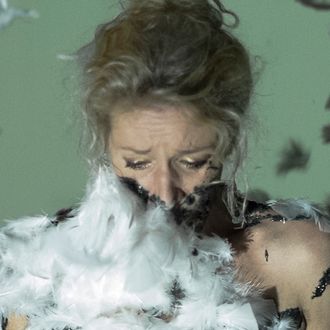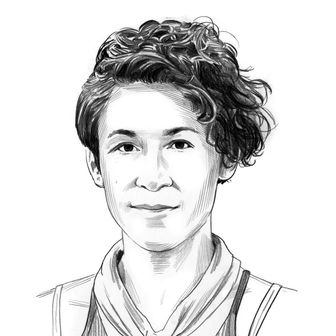
There’s a word in Russian: obraz. Translated simply it means image, but more accurately it refers to an icon or a sacred image, an image replete with expansive figurative meaning. More than a symbol, an obraz is an instant that contains an entire cosmos. It’s a moment as much as a picture: In a piece of theater, it’s that sudden shocking alchemy of elements — what you see, what you hear, what you feel — that bursts inside you like a psychophysical fusion bomb, revealing to you the whole play, sometimes it seems the whole world, in a single gesture. The Russian director who taught me the word called it “an image — but an image of God.”
The unmistakable work of Ivo van Hove has left me sometimes battered and elated (Roman Tragedies, A View From the Bridge), sometimes intermittently engaged and frustrated (The Crucible, Kings of War), and once — with the lumbering, bizarrely clueless The Fountainhead at BAM’s Next Wave Festival last fall — a seething combination of infuriated and catatonically bored that really shouldn’t be possible. But I’ll say this for the Belgian theater titan: He is an artist constantly in search of an obraz. Watching van Hove’s productions, I have the sense that play-making, for him, is a kind of grand game of connect the dots: He’s tracing the thread from one audacious theatrical gesture — if it’s successful, then, one obraz — to the next, and ensuring that he works with acting companies whose unswerving excellence and fortitude will keep the lines in between the peaks as taut and dangerous as tightropes. It doesn’t always work (despite our dumb perpetual need for those that we’ve dubbed geniuses to never falter), but when it does … good God. And it’s sure as hell working in van Hove’s methodically terrifying adaptation of Luchino Visconti’s 1969 film The Damned, now in a limited run at the Park Avenue Armory.
Actually, that’s not strictly accurate. The Damned — which premiered at the Avignon Festival in 2016 and which van Hove created with an ancient Parisian theater company, the Comédie-Française, and with his partner and always-collaborator, the scenographer Jan Versweyveld — is an adaptation of the screenplay by Visconti, Nicola Badalucco, and Enrico Medioli. It’s the fourth Visconti-led screenplay van Hove has turned into a play, as well as others by filmmakers like Bergman, Pasolini, Antonioni, and Cocteau. Van Hove avoids rewatching the movies themselves — “It is vital for me that the stage performance not be an adaptation of the film,” he’s said — and perhaps that makes even more sense for a director with his particular vocabulary than it might for a more lo-fi artist. Van Hove’s productions are rife with cutting-edge video technology. Teams of ninjalike cameramen and women, the unsung heroes of the van Hove–verse, follow the actors around like silent voyeuristic cats, capturing the nuances of their performances, and of their offstage preparation and downtime, on live feed. The Damned — for which Versweyveld has filled one end of the Armory with a vast flame-orange floor backed by a single huge LED screen that’s almost never free of some footage, whether live, pre-recorded, or historical — can at times feel like it’s almost more film than play. But despite the magnetic pull of that screen, the irresistible seduction and stimulation of a massive wall of shining pixels, the production is at its most visceral when its merciless images play out in the bodies of its actors — when it shows us, as it repeatedly does, a harrowing obraz in the flesh.
Take The Damned’s opening: The large company enters the stage to the earsplitting overlapping sound of a gong and a factory whistle. They stand spread out and facing us, straight-backed and hard-faced, like an army ready to advance, or perhaps prisoners spread out in the yard awaiting their fates. They are both. Hardly any of these characters will survive the story that unfolds in the next (intermission-less and consistently gripping) two hours and ten minutes, and van Hove will return to this stage picture — the cast facing front, lights suddenly up on the audience, the deafening whistle in our ears — at what feel like chapter breaks throughout the play. And each time, fewer and fewer bodies will stand there, fewer and fewer eyes will look back at us. When characters meet their individual ends, they progress out of the group — some in tears, some in stunned silence, some simply exhaustion — towards a fleet of coffins that sit waiting on a raised platform at the far left of the stage. As each one climbs in, filling his or her pre-appointed box, a man in black empties a jar of ashes into a large metal urn that stands downstage center. Over and over we watch these death rites — these executions — performed, until the stage is almost empty. The Damned takes place in Germany during the rise of Nazism, and with each return to this image, each enactment of this brutal ritual, van Hove traces the methodical erasure of more and more human beings.
The Damned tells the story of a dynasty of wealthy German industrialists, the steelworks-owning von Essenbecks, and their deepening collusion with the Nazi regime. It’s both a decadent family melodrama, filled with intrigue, perversion, and power-brokering — think the Medicis or the Borgias or the Lannisters — and a national allegory, the story of a country’s moral disintegration. Visconti, who loved Shakespeare and Verdi, wanted to make a film that translated the themes of Macbeth to the 20th century, and indeed, van Hove’s version of The Damned feels most akin to his productions of Shakespeare’s plays of wars and kings, especially the bloody power struggles of Henry VI. In that saga, as in The Damned, the world has become a perilously erratic place where, in the darkest way, “anything is possible” and “for [the] elite, everything is permitted.” Human ambition, resentment, greed, and hatred rend the moral fabric of the universe in two, opening a yawning maw of blank nihilism, and out of this hellmouth walks a soulless, sociopathic clown who will, while the world burns around him, ascend a mountain of bones and ashes to the throne.
Which is to say, The Damned is going to be called topical and relevant and perhaps even necessary. Flat words with a short shelf life. Words that make it seem like an unsparing examination of power — its cancerous, cowardly urge to increase itself, its inherent overwhelming violence — is more important on some days than others. Well, be that as it may. Whether we’re looking at Richard III, or at certain presidents, or at Martin — the von Essenbeck heir who starts as a kind of disturbingly vapid, moral-center–less doll and becomes a perfect embodiment of Nazi indoctrination, an empty vessel filled with wanton destruction — we’re looking at an aspect of humanity that, it would seem, doesn’t go away: the urge to fill the void where the soul should be.
“I believe that in life everything needs to be learned,” van Hove has said, “including love … We know nothing at the beginning. When we have not been educated in love, we cannot make love.” Martin (who’s brought to increasingly horrifying life by the sinuous, pretty-faced, dead-eyed Christophe Montenez) “may be perverse,” but he’s also the product of what he’s been taught and what he hasn’t. He’s destructive, sullen, easily bored, and easily provoked — and he’s got pedophilic urges. But it could be argued that, psychologically, he’s a child himself, a child who’s received a deadly combination of indulgence and wrist slaps rather than any actual help forming a character. He is the insidious product of his family’s history of self-absorption, accumulation, and lovelessness, and of his country’s mounting resentment and rage. He is Nazism — he’s any fascist plague of conscienceless cowardice — and, The Damned argues, he belongs to all of us.
“Nazism is our creation,” mourns Herbert Thallman (the seriously compelling Loïc Corbery) to his young cousin Günther, “[It was] born in our factories and nourished on our money … I did this. This is my fault.” Herbert is one of very few characters in The Damned with any kind of moral compass, and van Hove echoes his tortured revelation of responsibility by having the roving camerafolk turn their lenses on the audience more than once during the show, making a gloomy mirror of the big LED screen. But one man’s anguish is another man’s glee, as the Nazi commandant Wolf von Aschenbach (a slick, viperous Eric Génovèse) smirkingly explains to the steelworks foreman, Friedrich Bruckmann: “The complicity of our people is the great miracle of the Third Reich.”
The Damned is full of the broken, criminal, complicit, and corrupt, from the boorish brownshirt, Konstantin von Essenbeck (the stone-faced Denis Podalydès), to his father Joachim, the company patriarch (Didier Sandre, full of conflict as a high-toned but cowardly man of the old order, who “hates” the Nazis but won’t oppose them); from the ambitious, too-late-to-awaken Bruckmann to his pitiless lover, the Lady Macbeth–like Sophie von Essenbeck (Joachim’s daughter-in-law and Martin’s mother, played chillingly by Elsa Lepoivre), whose horrific fate at her own son’s hands is another appalling van Hovian obraz. You might not realize from this production, unless you’ve seen Visconti’s film, that the rage-bloated Martin ultimately rapes his mother, but van Hove’s envisioning of this climactic violation is somehow both more devastating and more meaningful for being nonliteral: He tars and feathers her. As Sophie stands naked, dripping with sludge and covered in eiderdown, we can see Martin’s act for what it really is, without the distraction of sex. It’s humiliation and degradation — and it’s both intimate and allegorical. The son has laid waste to the mother, and to the motherland.
But for all Martin’s heinous, head-spinning violence, von Aschenbach is The Damned’s real villain. He’s a vampire who swoops in to feed on the vulnerable, manipulating towards the most nefarious ends the likes of both Martin and Günther, who share nothing but pliability and a need for someone to see them. As these two young men move to embrace their most hateful instincts under von Aschenbach’s smooth, flattering guidance, it’s impossible not to think of the hundreds of young men in this country and around the world who’ve absorbed a twisted sense of self — at once inflated and debased — from the most toxic sources, and who’ve picked up a gun and used it.
It feels fair to include an actual trigger warning here: If you are an audience member who doesn’t like having a theatrical firearm pointed straight at you, beware. Though it would be poor form to reveal the ending of van Hove’s production, it must be said that The Damned’s punishing conclusion — which involves a machine gun and a man whose ash-coated body is quite literally white — stands as a final system-shocking obraz for our whole political moment. It shows us our child: the thing that we’ve bred and the toys that we’ve put in its hands to play with. It transcends time — 1934, 2018 — and makes a dreadful palimpsest of history and present. There’s no petty attempt at audience-shaming, no finger wagging or spurious call to action. Instead, van Hove and his undaunted ensemble simply require that we look, long and hard, without blinking. Here we are, their story tells us. Again.


